|
|
| |
SPAIN
GRENADA
Grenada is a city located in Granada Province in Andalucia, Southern Spain. In addition to a rich history and culture, Grenada's residents and tourists can enjoy a break from the hot summer weather as it is located at the foot of the Sierra Nevada mountains. Nearby is the Sierra Nevada Ski Station, where the FIS Alpine World Ski Championships 1996 were held. Granada is also well-known within Spain due to the prestigious University of Granada and boading a vibrant night-life. The Alhambra, a Moorish citadel and palace, is in Granada. It is one of the most famous items of the Islamic historical legacy that makes Granada a hot spot among cultural and tourist cities in Spain.
 View of Alhambra from San Nicolas square viewpoint
Photo: Tirithel
The Alhambra
The Alhambra is a palace and fortress complex constructed during the mid 14th century by the Moorish rulers of the Emirate of Granada in Al-Andalus, occupying the top of the hill of the Assabica on the southeastern border of the city of Granada, Spain. The Alhambra's Moorish palaces were built for the last Muslim Emirs in Spain and its court, of the Nasrid dynasty. It is now one of Spain's major tourist attractions, exhibiting the country's most significant and well known Islamic architecture, together with 16th-century and later Christian building and garden interventions. The Alhambra was declared a UNESCO World Heritage Site 1984.
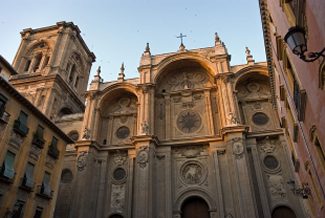 Cathedral of Granada from the south
Photo:
Pom²Granada Cathedral (Cathedral of the Incarnation)
The cathedral of Granada was built during the Spanish Renaissance over the Nasrid Great Mosque of Granada, in the center of the city. It was constructed as early as 16th century and contains the tombs of Ferdinand and Isabella, Juana la Loca, and Felipe el Hermoso. The church was conceived on the model of the Cathedral of Toledo, for what initially was a Gothic project, it was later steered towards Renaissance aesthetics when Diego Siloe took up the project in 1529. Alonso Cano introduced Baroque elements when he reformed the main facade.
Royal Chapel
The Royal Chapel of Granada is united and connected with other granadan important buildings as the Lonja and the Catedral e Iglesia del Sagrario. It was built over the former solar of the Great Mosque. There are buried the Catholic Monarchs, his daughter Joanna of Castile and Philip I of Castile. Its construction started in 1505 by Enrique Egas and in there it join the Gothic, present in factory and decoration, the Renaissance, in tombs, and the Granadan art of 17th and 18th centuries, present in the Chapel of Santa Cruz. Over the years was acquiring more works of art, liturgical objects and relics.
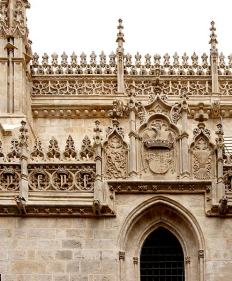 Royal Chapel of Granada
Photo: JebulonAlbayzín
The Albayzín (or Albaicín) is a neighborhood of Al-Andalus origin, much visited by tourists who flock to the city because of its historical connotations, architectural and landscapes. The archeological findings in the area show that the place was inhabited since ancient times. It is one of the ancient centers of Granada, as same as the Alhambra, the Realejo and the Arrabal de Bib-Rambla, in the flat part of the city. Its narrow streets are arranged in an intricate network that extends from the top, called San Nicolás, to the river Darro and Calle Elvira, located in Plaza Nueva. In 1994 it was declared a Unesco World Heritage Site.
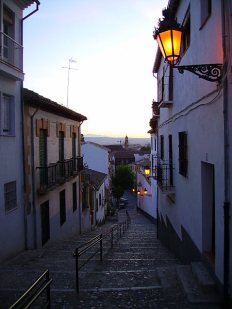 The Albayzín neighbourhoodSacromonte
The Sacromonte neighborhood is located in the Valparaíso hill, one of several hills that make up Granada. This neighborhood is known for be the old neighborhood of the gipsies, who settled in Granada after the conquest of the city. It is one of the neighborhoods most picturesque of the city, full of typical, whitewashed caves, where sound strumming guitars, cantes and "quejíos", so that over time has become one of the most important tourist attractions in Granada. At the top of this hill is the Abbey of Sacromonte and the College of Sacromonte, founded in the 17th century by the then Archbishop of Granada Pedro de Castro. The complex consists of the Catacombs, The Abbey (17th-18th centuries), the Colegio Viejo de San Dionisio Areopagita (17th century) and the Colegio Nuevo (19th century).
Granada Charterhouse
Granada Charterhouse is a Carthusian monastery in Granada, Spain. It is one of the finest examples of Spanish Baroque architecture. The charterhouse was founded in 1506; construction started ten years later, and continued for the following 300 years. While the exterior is a tame ember in comparison, the interior of the monastery's is a flamboyant explosion of ornamentation. Its complex echoing geometric surfaces make of it one of the masterpieces of Churrigueresque style. The most striking features include the tabernacle, constructed to a design by Francisco Hurtado Izquierdo.
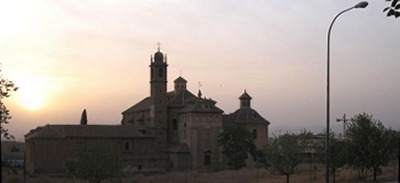 Charterhouse of Granada, SpainThe Generalife
The Generalife is a garden area attached to the Alhambra which became in place of recreation and rest of the Granadan Muslim kings when they wanted to flee the official life of the Palace. It was declared a World Heritage Site by UNESCO in 1984. It was built in the mid-13th century and was transformed by Abu I-Walid Isma'il. Is of Islamic Nasrid style. Today it is one of the biggest attractions of the city of Granada. The complex consists of the Patio de la Acequia (Court of the Water Channel or Water-Garden Courtyard), which has a long pool framed by flowerbeds, fountains, colonnades and pavilions, and the Jardín de la Sultana (Sultana's Garden or Courtyard of the Cypress). The former is thought to best preserve the style of the medieval Persian garden in Al-Andalus.
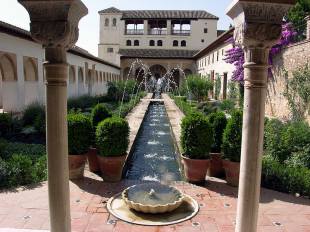 Generalife, the Court of la Acequia.
Photo: Loizeitung
The Rocket Festival takes place annually in May and is a celebration of music and alternative culture in the foothills of the beautiful Sierra de Almijarra 40km south west of Granada.
Sierra Nevada
Grenada is the perfect place from which to visit the famous Spanish Ski resort of Sierra Nevada. The resort is located 32 km from the centre of Granada and is only a 50-minute drive. It is possible to ski from early December to mid April. The Sierra Nevada (meaning "snowy range" in Spanish) contains the country's tallest mountains, rising to over 10,000 ft (3000+ metres). The highest peak is Mulhacén at 3,479 m. These high peaks make skiing possible in one of Europe's most southerly ski resorts, in an area along the Mediterranean Sea predominantly known for its warm temperatures and abundant sunshine.
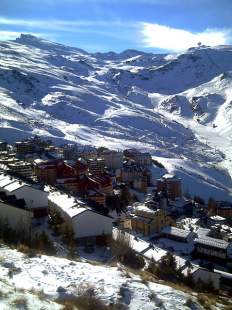 Pradollano resort in Sierra Nevada, Spain
Photo: Javier Martin
|
|
|
Festivals & Events
Seville Fair
The Feria de abril de Sevilla, literally Seville April Fair, is held
in the Andalusian capital of Seville, Spain. The fair generally begins
two weeks after the Semana Santa, or Easter Holy Week. The fair
officially begins at midnight on Monday, and runs six days, ending on
the following Sunday. Each day the fiesta begins with the parade of
carriages and riders, at midday, carrying Seville's leading citizens
which make their way to the bullring, La Real Maestranza, where the
bullfighters and breeders meet.
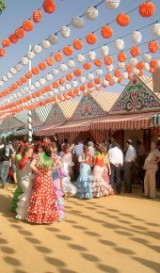 Casetas at Seville Fair
Photo: EdTarwinski
San Fermín
The festival of San Fermín is renowned for it's celebratory
tradition and is held in Pamplona anually on the 6th July. It is known
locally as Sanfermines and is held in honour of Saint Fermin. This
festival is important in terms of Spanish folklore and tradition. The
week long fiesta is most famous for it's encierro (running of the
bulls). It is belived that a million people flock to see this event
every year. The opening of the fiesta is marked by setting off the
pyrotechnic chupinazo. The rocket is launched at 12:00 noon on the 6th
of July from a city hall balcony with thousands of people celebrating
the act in the city hall square and other locations in Pamplona.
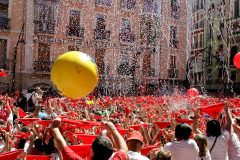 San Fermín Festival seen from
the Town Hall in Pamplona
Photo: Viajar24h
Fiestas del Pilar
Fiestas del Pilar is a large festival that takes place in Zaragoza,
Spain. This festival is religiously rooted in Spain and based on the
belief that Virgin Mary appeared to Saint James standing on a pillar.
The celebration lasts for seven days during which the city is bustling
with energy as over two million people visit the city for this fiesta.
Every day at 8 o'clock in the morning there is an event called
vaquillas, that is amateur bullfighting in the towns bullfighting ring,
or Plaza de toros. Everyone who is brave enough, can participate in this
event, in which many people get injured every year. The most important
celebration takes place on the 12th October, "The offering of flowers"
to the Virgin, who is removed from the Basilica and exhibited in a
platform placed on the square where the temple lies. The Offering of
Flowers is one of the more famous festive symbols of Spain.
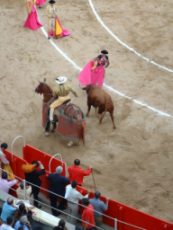 San Fermín Festival seen from
Bull running in Barcelona
Photo: BPG
Carnival
Carnival is a festive season which occurs immediately before Lent;
the main events are usually during February. Carnival typically involves
a public celebration or parade combining some elements of a circus,
mask and public street party. The Santa Cruz de Tenerifeand Las Palmas
de Gran Canaria is together with the Carnival of Cadiz, the most
important festival for Spanish tourism and Spain's largest carnival. In
Catalonia people dress up and organise parties for a week but
particularly on the weekend. Despite it being winter, parties are open
air, beginning with a cercavila to call everybody to come. Rues of
people dance along the streets. On Thursday Dijous Gras is celebrated,
also called 'the omelette day' and omelettes are eaten. Parties end by
burning Mr. Carnestoltes and with enterrament de la sardina (sardine's
funeral). Carnaval de Solsona takes place in Solsona, Lleida in central
Catalonia. It is one of the longest carnivals in Catalonia; free events
in the streets, and concerts every night, run for more than a week.
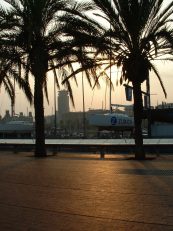 Barcelona harbour
Photo: BPG
Festival Internacional de Benicàssim
The Festival Internacional de Benicàssim is an annual music festival
sponsored by a well known beer label which takes place in the village of
Benicàssim, province of Castelló, Valencian Community in Spain. It
focuses mainly on pop, rock and electronica artists, as well as having
other elements besides music like short films, theatre, fashion and art.
Since the first festival in 1995, some of the most notable artists who
have played the festival include Paul Weller, Depeche Mode, Beck,
Radiohead, Kraftwerk, The Stone Roses, Brian Wilson, Blur, Lou Reed,
Oasis, The Chemical Brothers, Franz Ferdinand, The Killers, Morrissey,
Sigur Rós, Ride and The Strokes. As of 28 January, the line up for the
2011 Festival is as follows: Arcade Fire, Arctic Monkeys, Mumford &
Sons, Portishead, The Strokes, Beirut, Catpeople, Elbow, Friendly Fires,
Julieta Venegas, Lori Meyers, Primal Scream (present Screamadelica),
The Streets, Tinie Tempah, The Coronas, Grupo Salvaje, The Marzipan Man
Smile, Veronica Falls, Paolo Nutini, Pendulum, Mahmiri Acar. 'FIB' is
held in the seaside resort of Benicassim (Castellón province) on Costa
del Azahar, Valencia, Spain, 92.2 km away from Valencia Airport.
Festival goers who have purchased multi-day passes can camp for up to 9
days starting Monday before the festival starts and ending Tuesday after
the festival has ended. For more information please contact info@fiberfib.com
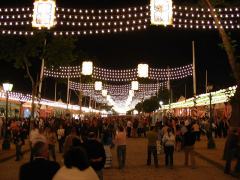
Festimad
Festimad is an alternative rock festival and cultural event held yearly
in Madrid, Spain since 1994, usually in the last week of May. Festimad
includes several parallel cultural festivals such as Performa, Graffiti,
Universimad o Cinemad, although its central event continues to be the
music festival, standing alongside the Festival Internacional de
Benicàssim as Spain's main rock concert. For more information please
contact festimad@festimad.es
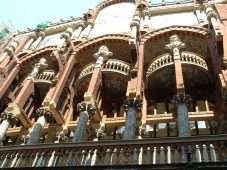 Photo: BPG
Bilbao Live Festival
The Bilbao Live Festival is a rock and pop music festival that takes
place in the summer in Bilbao, Spain since 2006. It is supported by BBK
the savings bank. Some 51,000 people attended the first edition of
Bilbao Live Festival in 2006, an event that reunited during three days
more than 40 national and international bands of rock and carps of
electronic music. Bilbao had thus burst in with force into the circuit
of great musical festivals of the summer time. The 2011 lineup includes
Coldplay, Blondie, Beady Eye, Crystal Castles, Russian Red, Ken Zazpi,
Amy Winehouse, Kasabian, Kaiser Chiefs, The Black Crowes, The Chemical
Brothers, Jack Johnson, 30 Seconds to Mars, M-Clan. For more information
please contact festivals@nme.com
|